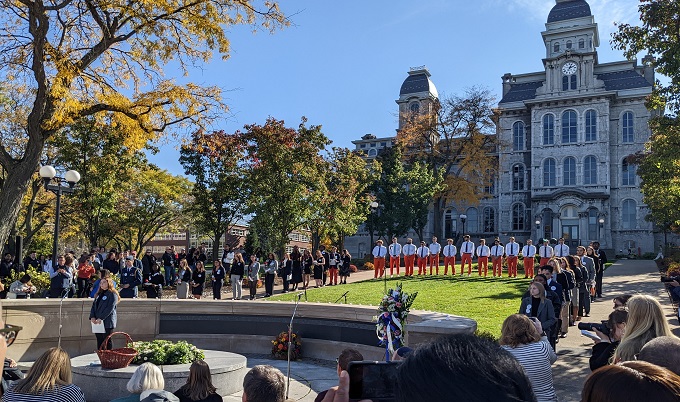Lockerbie memories
Researchers gather memories of Lockerbie disaster
Published on: 20 December 2022
Reflections on the immediate aftermath of the Lockerbie bombing from police officers and other first responders have been gathered as part of a Newcastle University research project.
Dr Andy Clark from the University’s School of History, Classics and Archaeology’s Oral History Unit carried out interviews with a number of former officers from the Dumfries and Galloway and Strathclyde forces who were the first on the scene on 21 December 1988 when flight Pan-Am 103 exploded over Lockerbie, killing everyone on board and 11 people on the ground.
It is the UK’s deadliest terrorist attack. Of the 270 fatalities, 190 were American citizens and 43 were British. Nineteen other nationalities were among those killed. Among those who died were 35 students from Syracuse University, US, who were returning home for Christmas following a semester in Syracuse's London and European campuses.
Working with Dr Colin Atkinson, a researcher in Counter Terrorism at the University of the West of Scotland, Dr Clark aimed to collect memories from those involved in the search and rescue operation to better understand the impact of an event with such global significance on officers from the smallest police force in Scotland, and how the event is remembered more than 30 years later.
The broken-up wreckage of the plane was scattered over 2,000 square kilometres across southern Scotland and northern England, so the research team also spoke to mountain rescue volunteers who searched Kielder Forest for debris from the disaster.
“There has - rightly - been much focus on those who tragically perished in the bombing, and the impact on their families, but the voices of the people whose job it was to recover the debris, and deal with scenes we can’t even begin to imagine, to piece together what happened has never been researched,” said Dr Clark. “All these years later, it’s important to understand how the people who were there in the immediate aftermath as part of their day-to-day job remember the event and how it is commemorated.”
They found that although many of the - now retired - police officers felt the burden of the responsibility of dealing with and investigating one of the worst tragedies the world has ever known, there was also a sense of wanting to do a professional job and many of the participants spoke of how they felt it was important to do the best they could for the families who were grieving.
The research, which was funded by the British Academy, also identified there was a strong wish to remember and commemorate those who died. Alongside this, there was also a desire to move forward, and this has been achieved in part through new links between Lockerbie and Syracuse and other communities impacted in some way by the disaster.
Dr Clark and Dr Atkinson have just returned from Syracuse University, New York, where they shared their research and took part in the University’s annual Remembrance Week. As part of the commemorations, each year 35 Remembrance Scholars are selected to represent and memorialise the 35 students who died in the disaster, while two students from Lockerbie are selected to study at Syracuse for a year. The Remembrance Scholars plan the week’s events, which aim to fulfil the mission of “Look Back, Act Forward” in memory of those lost.
In addition to discussing their research, Dr Clark and Dr Atkinson met with some of the families to talk to them about how the work is helping to enhance understanding of the tragic event and its ramifications.
They also worked with the extensive Pan Am 103 archives at Syracuse University to understand more about the disaster from the US perspective. The archives contain records relating to the disaster and its aftermath, including media coverage and government documents, as well as materials documenting the lives of the victims such as correspondence, photographs, writings and journals, and a number of personal belongings.
“From speaking to the families, there was a real sense of gratitude to the police officers in the town and the people of Lockerbie for the dignity and respect that they showed,” said Dr Clark. “For example, despite their own losses and trauma, some of the residents of Lockerbie at the time had washed, dried and ironed every piece of clothing that was found, so that as many items as possible could be returned to the relatives.
“Next year will be the 35th anniversary of the disaster and all the people we spoke to stressed how important it was to look at the bridges that have been built between two communities that wouldn’t have otherwise been connected. We want our research to contribute to those links and be one way of ensuring the victims and everyone else involved in the disaster are remembered.”




